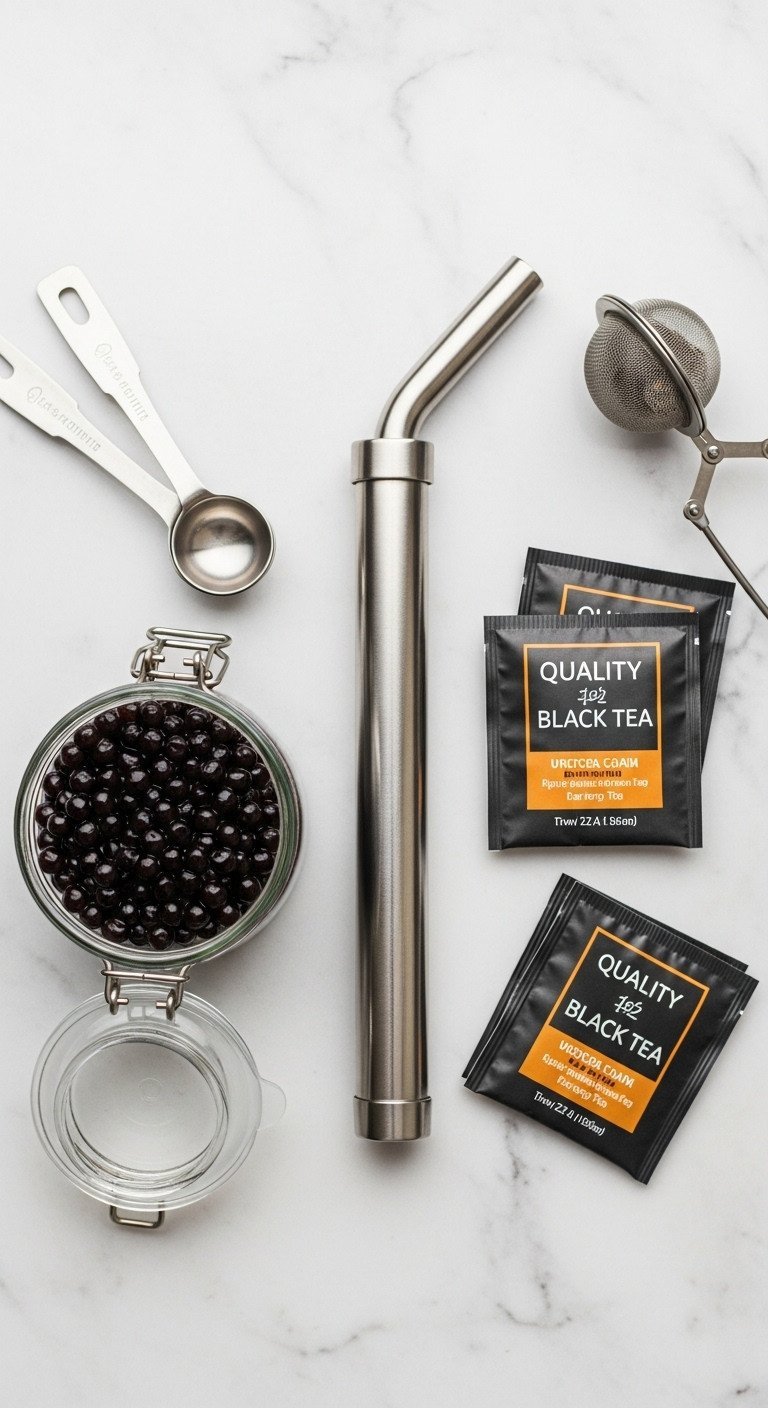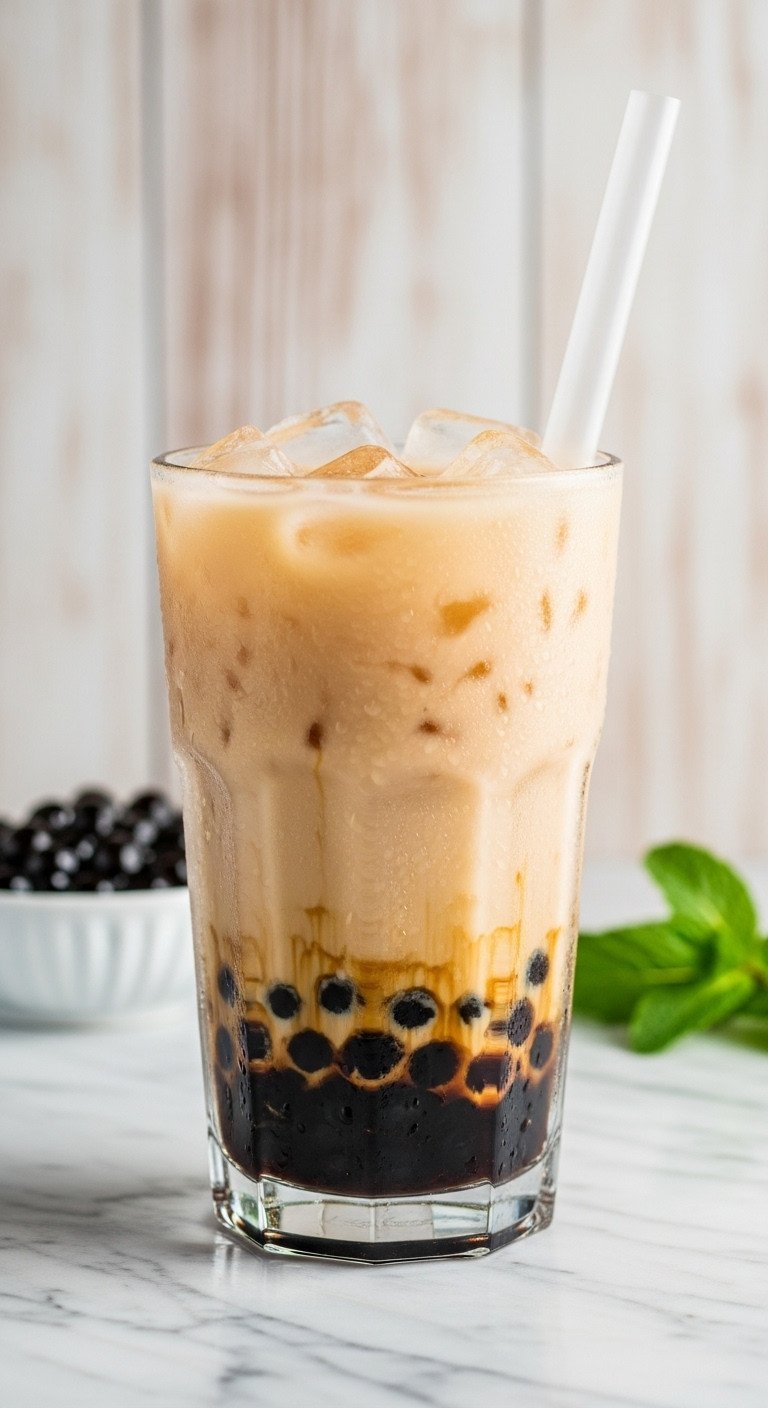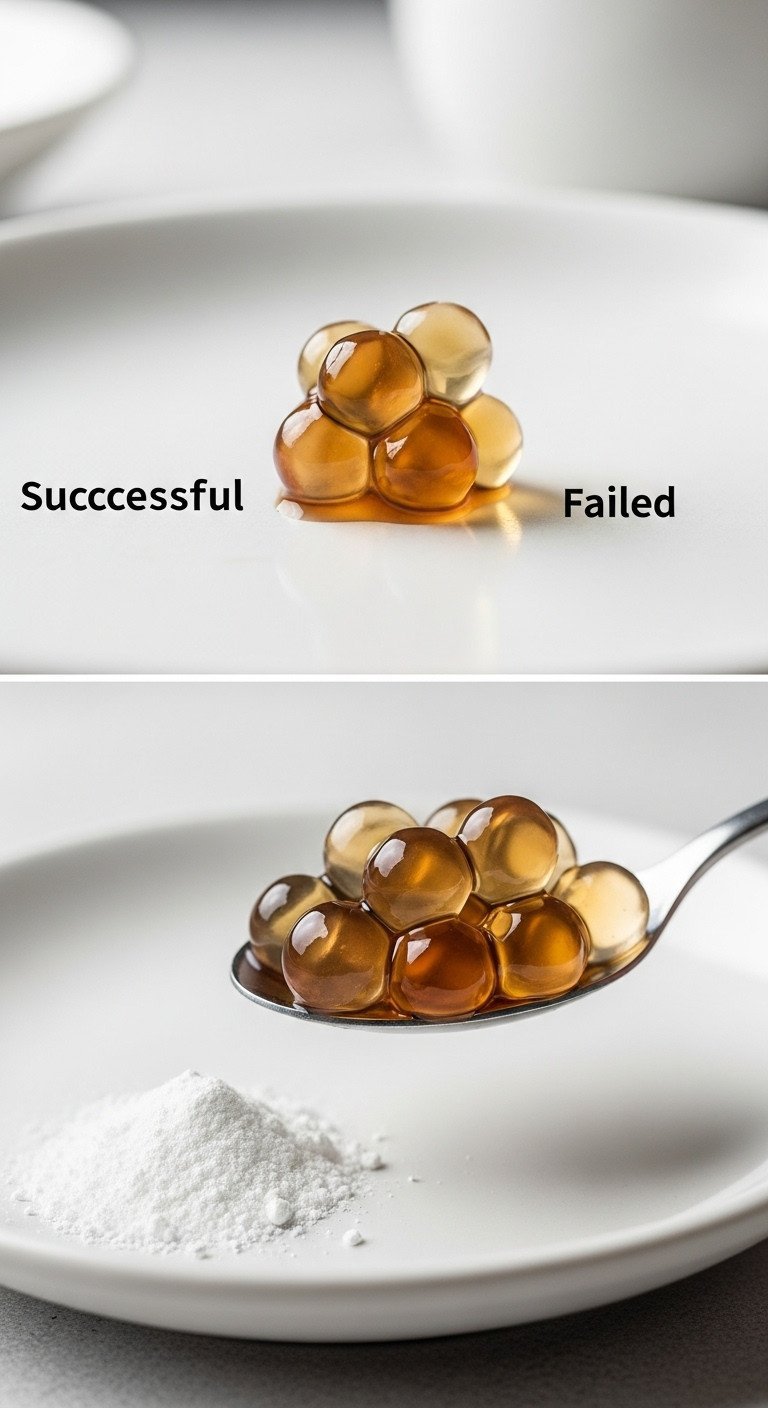As an Amazon Associate CoffeeXplore.com earns from qualifying purchases.
Master The Perfect Boba Tea Recipe For Chewy Pearls
Struggling to make boba tea that tastes like the cafe? You’re not alone. So many homemade attempts end up with hard, chalky pearls and a watery, bland tea base, leaving you wondering what went wrong.
You’ve found the right place to fix it. This is a complete boba tea recipe, a culinary procedure for the classic Taiwanese beverage. We’ll solve the common problems that lead to disappointment. You’re about to learn the secrets behind that perfect chewiness and rich flavor.
The perfect Boba Tea consists of four main components: 1. Chewy Tapioca Pearls, 2. A Robust Black Tea Base, 3. Rich Milk or Creamer, and 4. A Deeply Flavored Sweetener. This guide breaks down each part with precise, tested steps. You will master the authentic texture and taste you crave, right in your own kitchen.
Why Your Homemade Boba Tea Tastes Watery (And How to Fix It)
The most common reasons for disappointing homemade boba tea are a weak tea base and improperly cooked tapioca pearls. A watery drink happens when your tea isn’t brewed strong enough to stand up to the milk and ice. Hard or mushy pearls are almost always a result of incorrect boiling times and a failure to marinate them properly immediately after cooking.
To achieve that authentic, store-bought quality, you must master four essential components. Each one plays a critical role in the final flavor and texture. According to professional standards, achieving the signature chewy ‘Q’ texture in the tapioca pearls and a robust, non-watery milk tea base requires precise ratios and proven techniques. This isn’t just about mixing ingredients; it’s about a specific culinary process. We will walk through each of these components to guarantee your success.
9 Steps to Master The Perfect Boba Tea Recipe for Chewy Pearls
This step-by-step guide is more than just a list of ingredients. It’s a holistic method designed to help you create the perfect bubble tea from scratch, covering everything from ingredient sourcing to the final assembly. By integrating the culinary science behind starch gelatinization and tea tannin extraction, this authentic Taiwanese boba recipe maximizes your chance of success. Follow these nine steps precisely to achieve chewy pearls and a rich, flavorful milk tea every single time.
1. Sourcing the Right Boba Pearls and Essential Tools

Pin this genius hack to your ‘DIY Drinks’ board!
Success starts with the right ingredients and tools. Sourcing high-quality, quick-cooking tapioca pearls and a robust black tea will make a significant difference in the final taste and texture.
Materials Needed:
- 1 cup Quick-Cooking Tapioca Pearls (look for brands requiring 5-10 minutes boil time)
- High-Quality Black Tea (Assam or Ceylon loose leaf, or premium tea bags)
- Milk or Creamer (Whole milk, Half-and-Half, or Barista Oat Milk for best results)
- Sweetener (Dark brown sugar and granulated sugar for syrup)
- Wide, Reusable Boba Straws (Essential for the consumption experience)
Preparation Checklist:
- Check the label: Confirm the type of boba—standard dried pearls take 25+ minutes; quick-cook takes 5-10 minutes. Adjust timing accordingly.
- Gather Equipment: Ensure you have a medium saucepan (for the pearls) and a separate kettle or pot (for the tea).
- Filter Water: Use fresh, filtered water for both the tea and the pearls, as tap water minerals can affect flavor and starch quality.
- Pre-Measure: Set aside your tea and boba measurements before beginning the cooking process for speed.
Pro-Tip: The quick-cook boba is ideal for beginners, but for the truly authentic ‘Q’ texture, opt for standard dried pearls, which require longer boiling (30 mins).
2. Crafting the Rich, Caramelized Brown Sugar Syrup

Save this clever organization idea!
The brown sugar syrup does more than just sweeten your drink; it marinates the tapioca pearls, giving them their iconic flavor and preventing them from sticking together.
Ingredients Needed:
- 1 cup Dark Brown Sugar (packed)
- 1/2 cup Water (filtered)
- 1 teaspoon Vanilla Extract (optional, enhances caramel flavor)
Syrup Cooking Steps:
- Dissolve: Combine the brown sugar and water in a small, non-stick saucepan over medium-high heat. Stir constantly until all the sugar is completely dissolved (about 2 minutes).
- Simmer & Thicken: Reduce the heat to medium-low and allow the syrup to simmer gently for 8–10 minutes. Avoid aggressive stirring during this phase. The syrup should reduce slightly and thicken enough to coat the back of a spoon.
- Cool: Remove the saucepan from the heat immediately. Stir in the vanilla extract, if using. Keep the syrup warm (not hot) until the pearls are ready, as it is crucial for optimal marination.
- Safety Warning: Boiling sugar is extremely hot. Handle the saucepan with caution to prevent burns.
Lesson Learned: A common mistake is using a simple syrup (1:1 sugar:water, no simmering). For the authentic dark color and rich caramel flavor, you must use dark brown sugar and simmer until slightly thick.
3. The Critical Step: Cooking the Boba Pearls for Optimal ‘Q’ Texture

Pin this technique to avoid hard boba!
This is where most homemade recipes fail. Achieving the perfect chewy, bouncy, and soft ‘Q’ texture requires precise timing and a two-stage cooking process.
Materials Needed:
- 7 cups Filtered Water
- 1 cup Dried Tapioca Pearls (quick-cook or standard)
- Large Saucepan
Precise Pearl Cooking Steps:
- Bring to Boil: Bring 7 cups of water to a rolling, vigorous boil in a large saucepan. The high water ratio (7:1) prevents sticking.
- Add Pearls: Carefully pour the tapioca pearls into the boiling water and stir immediately to prevent them from sticking to the bottom.
- Initial Boil: Once the pearls float (about 30 seconds), reduce the heat to maintain a strong simmer. Cook for 25 minutes (for standard pearls) or 5-8 minutes (for quick-cook pearls).
- Steep: Turn off the heat. Cover the pot with a lid and let the pearls steep for an additional 10-15 minutes. This off-heat rest time is crucial for cooking the centers without causing mushiness.
- Test: Scoop one pearl out and cut it in half. The ideal texture is fully translucent with no white, hard center, yet still firm and elastic (the ‘Q’ factor).
Expert Technique: Do not skip the off-heat steep time. The residual heat finishes the gelatinization process slowly, ensuring the pearls are cooked through yet retain their signature chewiness.
4. The Flavor Infusion: Marinating the Cooked Pearls Immediately

Save this clever organization idea!
Once cooked, tapioca pearls are extremely sticky due to their starch content. This step is non-negotiable for preventing them from clumping into an inedible mass.
Supplies Needed:
- Cooked Tapioca Pearls (from Step 3)
- Fine Mesh Strainer
- Warm Brown Sugar Syrup (from Step 2)
Marinating Steps:
- Rinse Thoroughly: Immediately strain the cooked pearls. Place them under warm running water for about 30 seconds, tossing gently. This step removes excess starch that causes clumping. Do NOT use cold water, as this will shock the starch and cause the pearls to rapidly harden.
- Transfer to Syrup: While the pearls are still warm (crucial!), immediately transfer them from the strainer directly into the bowl of warm brown sugar syrup.
- Toss and Steep: Toss the pearls gently until they are fully coated. Let them marinate at room temperature for a minimum of 30 minutes, or up to 4 hours. The pearls will absorb the rich flavor and remain soft and non-sticky.
Pro-Tip: If you need to stop the cooking process for a batch of pearls you don’t plan to use immediately, drain them immediately after step 4, rinse with warm water, and freeze them uncooked. Cooked pearls must be consumed fresh.
5. Brewing the Double-Strength Black Tea Base

Pin this technique for a non-watery tea!
The secret to a rich, flavorful milk tea that doesn’t taste diluted is brewing the tea at double its normal strength. This ensures the tea’s character shines through even after adding milk and ice.
Ingredients Needed:
- 4 cups Filtered Water
- 6 Black Tea Bags (or 3 tablespoons loose leaf black tea)
- 1/4 cup Granulated Sugar or Simple Syrup (optional, pre-sweetening)
Precise Brewing Steps (Double Strength):
- Heat Water: Bring the water almost to a boil (around 95°C or 203°F). Boiling water can scorch the leaves and release excessive tannins, resulting in a bitter flavor.
- Steep: Place the tea bags or loose leaf in the hot water. Use double the amount of tea you would normally use for drinking (e.g., 6 bags for 4 cups). Cover and steep for exactly 6 minutes.
- Strain: Remove the tea bags or strain the loose leaf immediately after 6 minutes. Over-steeping will cause bitterness.
- Pre-Sweeten (Optional): If using granulated sugar, stir 1/4 cup into the hot tea until fully dissolved. For simple syrup, add it later.
- Cool: Allow the brewed tea to cool to room temperature or chill slightly in the refrigerator before mixing with milk and ice.
Expertise Insight: The 6-minute steep time is a sweet spot for black tea intended for milk drinks—it maximizes flavor extraction without pulling too many bitter tannins.
6. Balancing the Ratios: Mixing the Creamy Milk Tea Base

Save this perfect ratio formula!
The creaminess of your milk tea depends on the type of milk you use and the ratio of tea to milk. The goal is a rich, balanced base that is neither watery nor overly milky.
Ingredients Needed:
- 4 cups Cooled Black Tea (from Step 5)
- 4 cups Milk (Whole Milk, Half-and-Half, or Oat Milk)
- Optional: 1/4 cup Sweetened Condensed Milk (for added richness)
Mixing the Base:
- Achieve 1:1 Ratio: Combine the cooled, strong black tea with an equal volume of your chosen milk/creamer (4 parts tea to 4 parts milk is the starting point). This 1:1 ratio is crucial for balancing the double-strength tea.
- Add Creamer: If using condensed milk for extra richness, stir it in now until fully combined.
- Chill: Place the entire milk tea base in the refrigerator until ready to serve. Serving the base chilled prevents rapid melting of ice during assembly.
- Taste Test: Taste the base and adjust sweetness before adding the boba and ice, keeping in mind the pearls and syrup are already very sweet.
Pro-Tip: For the creamiest, most authentic texture, Barista-edition Oat Milk or Half-and-Half provides the best balance of fat and neutral flavor compared to standard skim or almond milk.
7. The Final Layering and Aesthetic Assembly

Pin this perfect assembly sequence!
With all your components ready, the final step is to assemble the drink. The order of layering is important for both the visual appeal and the final taste experience.
Materials Needed:
- Cooked and Marinated Boba Pearls
- Chilled Milk Tea Base
- Ice Cubes
- Tall Glass or Boba Tumbler
Assembly Steps (Per Serving):
- Pearl Base: Scoop 1/4 to 1/3 cup of the marinated boba pearls and the associated brown sugar syrup into the bottom of your tall glass.
- Ice Layer: Fill the glass nearly to the top with fresh ice cubes. Ice must be added before the milk tea base to ensure rapid chilling and limit further pearl softening.
- Pour Milk Tea: Gently pour 1 cup (250ml) of the chilled Milk Tea Base over the ice, filling the glass. The liquid should flow smoothly around the boba and ice, creating distinct layers.
- Serve: Insert a wide boba straw. Gently stir the drink 1-2 times just before consuming to mix the heavy syrup layer with the milk tea.
Pro-Tip: For the trendy “Tiger Sugar” effect, drizzle a tablespoon of extra brown sugar syrup along the inner walls of the glass before adding the pearls and ice in step 1.
8. Troubleshooting: Fixing Hard, Mushy, or Clumpy Boba Pearls

Pin this for emergency boba repair!
Even with careful steps, things can go wrong. This section, an often-overlooked strategy in many guides, provides expert solutions to the most common texture problems, helping you save your batch and learn from mistakes.
Problem & Solution Guide:
- Problem 1: Hard, Chalky Centers:
- Root Cause: Insufficient boiling and/or steeping time.
- Solution: Re-boil the pearls in fresh water for an additional 5-10 minutes, then ensure a full 15-minute steep off the heat. If they hardened after being cooled, they cannot be salvaged.
- Problem 2: Mushy or Dissolving Pearls:
- Root Cause: Over-boiling or boiling too vigorously; or excessive heat exposure after cooking.
- Solution: Immediately stop boiling. Reduce the boiling time for the next batch and rely more heavily on the off-heat steeping period (Step 3).
- Problem 3: Clumping Together:
- Root Cause: Starch residue was not washed off, and/or the pearls were not transferred immediately to warm syrup.
- Solution: Ensure thorough rinsing with warm water after straining (Step 4) and use plenty of warm syrup to coat every surface of the pearls right away.
Storage Warning:
- NEVER Refrigerate Cooked Boba: Refrigeration causes rapid starch retrogradation, turning the pearls hard and inedible.
- Optimal Storage: Cooked, syruped pearls must be kept at room temperature and consumed within 4 to 6 hours for optimal texture. Discard any leftovers stored longer than 6 hours for safety and quality.
Lesson Learned: The biggest mistake home cooks make is refrigerating leftovers. Prepare only the amount of boba you plan to consume immediately.
9. Mastering Low-Sugar and Vegan Swaps

Pin this for the best low-calorie boba!
One of the best parts of making boba at home is customizing it to your dietary needs. This recipe can easily be adapted for vegan or low-sugar lifestyles without sacrificing taste or texture.
Vegan & Low-Sugar Substitutes:
- Milk Swap: Barista Oat Milk (Highest fat content, best texture) or full-fat Coconut Milk (adds a slight flavor).
- Syrup Swap: Liquid Monk Fruit Sweetener or Erythritol Syrup (ensure it is liquid, as dry substitutes won’t dissolve properly in cold tea).
- Tea Base: Matcha Powder (whisked into hot water) or Jasmine Green Tea (steeped strongly).
Low-Sugar Syrup Steps:
- Mix Base: Combine 1/2 cup water and 1/2 cup granulated Erythritol in a saucepan. Heat until fully dissolved.
- Thicken: Add 1-2 teaspoons of Xantham Gum or another thickener if desired, whisking vigorously until the desired syrup consistency is reached.
- Add Flavor: Stir in a few drops of caramel or dark brown sugar extract, plus liquid Monk Fruit drops to taste, ensuring a potent sweetness profile.
Expert Tip: When using alternative sweeteners, they often lack the viscosity of real sugar. Using a tiny amount of a natural thickener like xanthan gum can help your alternative syrup cling to the pearls better.
Key Takeaways: Your Quick Guide to Perfect Boba
For a quick review, remember these three non-negotiable rules. Mastering them is the key to achieving that perfect boba consistency and flavor every time.
The Three Rules for Chewy ‘Q’ Texture
- Rule 1: Never Refrigerate Cooked Pearls: Consume within 4-6 hours or discard.
- Rule 2: Rinse and Marinate Immediately: Rinse with warm water to remove starch, then plunge immediately into warm syrup to prevent sticking and hardening.
- Rule 3: Use Double-Strength Tea: Your tea base must be concentrated (using 2X tea) to withstand the dilution from milk and ice without becoming watery.
People Also Ask About Boba Tea Preparation
How long can I store cooked tapioca pearls?
Cooked boba pearls should not be stored in the refrigerator, as the cold causes the starch to harden. For optimal texture, they must be kept in the brown sugar syrup at room temperature and consumed within 4 to 6 hours of cooking. If you need to prepare ahead, store the dried, uncooked pearls in an airtight container for up to November 2025.
Is it cheaper to make boba tea at home than buying it at a store?
Yes, making boba tea at home is significantly cheaper, often reducing the cost per serving by 70-80%. While the initial investment in dried boba pearls, tea, and wide straws may seem high, bulk purchasing these core ingredients drastically lowers the price per cup compared to café prices.
Can I use regular white sugar instead of brown sugar syrup for boba?
It is strongly recommended to use a simple syrup (dissolved sugar) rather than dry white sugar for boba tea. Dry sugar will not dissolve completely in cold tea, resulting in a grainy texture. While brown sugar offers a superior, more authentic caramelized flavor, a homemade simple syrup (1:1 dissolved sugar:water) is a functional substitute.
What is the ideal ratio of milk tea base to sweetener?
The ideal ratio starts at 1:1 strong tea base to milk/creamer, with 1 to 2 tablespoons of the prepared sugar syrup per serving. However, this ratio is highly customizable. It is best practice to mix the milk tea base, taste it, and then adjust the syrup volume until the desired sweetness level is reached.
Final Thoughts
If you master the three crucial techniques—the precise boiling time for the pearls, the immediate warm syrup bath, and the double-strength tea base—you have successfully unlocked the secret to authentic, chewy, and flavorful bubble tea at home. No more watery, bland bases or hard, chalky pearls! You now possess the expert knowledge to customize and perfect this classic Taiwanese beverage.
What is your favorite boba tea flavor, and which one will you try making first with your perfectly chewy pearls? Tell us in the comments below
Last update on 2025-11-19 / Affiliate links / Images from Amazon Product Advertising API

